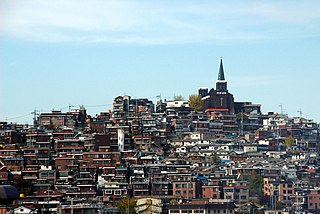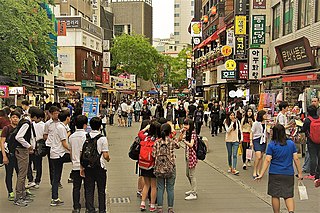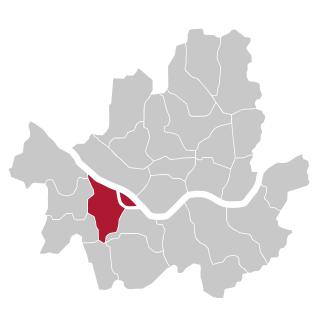Gwangju is the sixth-largest city in South Korea. It is a designated metropolitan city under the direct control of the central government's Home Minister. The city was also the capital of South Jeolla Province until the provincial office moved to the southern village of Namak in Muan County in 2005 because Gwangju was promoted to a metropolitan city and was independent from South Jeolla province.

Yongsan District is one of the 25 districts of Seoul, South Korea.

Insa-dong is a dong, or neighborhood of the Jongno-gu district of Seoul. The main street is Insadong-gil, which is connected to a multitude of alleys that lead deeper into the district, with modern galleries and tea shops. At one time it was the largest market for antiques and artworks in Korea.

Buk District (Buk-gu) is a district situated in the northern part of the city of Gwangju, South Korea. It is similar to a ward in the United States. The district is by far the most populated district in Gwangju, and elects two lawmakers for the South Korean National Assembly. Gwangju Station is here.

Yeongdeungpo District (Yeongdeungpo-gu) is an administrative district in southwest Seoul, South Korea. Although the origin of the name is uncertain, the first two syllables are thought to be from "yeongdeung" (靈登) or "divine ascent", a shamanic rite. The third syllable is "po", representing the bank of a river (浦), referring to the district's position on the Han River. The 2006 population was 408,819. The current magistrate is Kim Hyung-Su.

Dong District is a gu in central Busan, South Korea. It was one of the first 6 gu of Busan established in 1957.

Jung District is one of the 25 districts of Seoul, South Korea.

Gangseo District (Gangseo-gu) is one of the 25 wards (gu) of Seoul, South Korea. It is located on the south side of the Han River. Gimpo Airport is in Gonghang-dong, where many flights fly to cities like Busan, Jeju, and Gwangju.

Gwangjin District (Gwangjin-gu) is one of the 25 wards (gu) of Seoul, South Korea. It is located on the north bank of the Han River, to the eastern end of Seoul It was created from neighboring Seongdong District in 1995.
Gwangju University began in 1981 as a four-year college in Jinwol-dong, Nam-gu, Gwangju, named Gwangju Gyeongsang Jeonmun Daehak (Korean: 광주경상전문대학). It now has three graduate schools and four colleges with more than fifteen thousand students.

Gwangju Station is a train station located in Gwangju, South Korea, 353 km south of Yongsan Station.

Gwangsan District (Gwangsan-gu) is a district, similar to a ward, situated in the city of Gwangju, South Korea. The total population of the district, as of September 2004, is 295,294, and the population density of the district is 1,085 per 1 km. Its area is about 45% of the city of Gwangju.

Bupyeong District (Bupyeong-gu) is one of the 10 administrative divisions that comprise Incheon, South Korea. Bupyeong-gu comprises an area of 12.35 square miles, and has a population of 544,606. It is located north of Namdong-gu, east of Seo-gu, and south of Gyeyang-gu. The city of Bucheon, in neighboring Gyeonggi Province, comprises its eastern limit.

Samseong-Dong is an affluent neighborhood or ward of Gangnam-gu in Seoul, South Korea.

Yangjae-dong is a dong, neighbourhood of Seocho-gu in Seoul, South Korea. Yangjae-dong is divided into 2 different dong which are Yangjae 1-dong and 2-dong.
Sillim or Sillim-dong is a statutory division of Gwanak District, Seoul, South Korea. Seoul National University and Nokdu Street are located in the town. Its name means "new forest", which was derived from the woods outstretched from Mt. Gwanak. It consists 11 administrative neighbourhoods.

Sogong-dong is a dong, neighbourhood of Jung-gu in Seoul, South Korea.

Nam District (Nam-gu) is a district of Ulsan, South Korea. Its name literally means "South Ward".

Nam District is the southern district of Gwangju (광주광역시), South Korea. 'Nam'(南) means 'south' in Korean hanja. 'gu'(區) means 'district' of metropolitan city in Korean hanja.

Seo District (Seo-gu) is a district of Gwangju, South Korea. Its hanja transcription means "west district", but it is in the center of the city. Its city hall and a convention center are famous landmarks in the district.
















